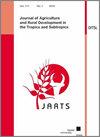Morphology, biochemistry, and management of Russian olive (Elaeagnus angustifolia L.) accessions in Gilgit-Baltistan, northern Pakistan
Q3 Social Sciences
Journal of Agriculture and Rural Development in the Tropics and Subtropics
Pub Date : 2020-08-12
DOI:10.17170/KOBRA-202007291507
引用次数: 3
Abstract
Russian olive ( Elaeagnus angustifolia L., Elagnaceae) is a native multi-purpose medicinal shrub or tree of Asian regions and an integral component of high altitude terraced agroforestry systems of Gilgit-Baltistan, northern Pakistan. The strong increase in deforestation, urbanisation, and the loss of ethnically-based medication practices in local communities are gradually leading to depletion of its stands and knowledge of its use. In view of these circumstances, this study was undertaken to characterise Russian olive accessions as a first step towards the conservation of this important wild plant genetic resource. Ninety-three fruits (including seeds) and leaves were sampled to determine morphological variability among accessions. In addition, the phenolic composition of fruit pulp of 40 fruits was used for determination of phenolic compounds. To assess the local importance of the fruit, 42 Russian olive collectors and traders were interviewed. Data were analysed using PCA and clustering approaches. Fruit traits across groups were equally shared. Elevation had a positive effect on fruit and seed dimensions especially on length (r = 0.606 and 0.515, respectively) and weight (r = 0.618 and 0.695, respectively). Bioactive substances such as DPPH and flavonoids in the sampled fruits exceeded most values found in the literature by a factor of 100 and 30, respectively. The socio-economic household analysis highlighted that Russian olive harvest and trade is a purely additional income strategy. On average, about 90 € (ca. 16000 PKR) were earned by one household ranging from about 35 € to about 205 € per year. Data yielded a mixed picture on morphological and biochemical diversity as well as the socio-economic background, but indicated that northern regions of Pakistan might be an important centre for biodiversity of this species in Central Asia, which merits improved marketing.巴基斯坦北部吉尔吉特-巴尔蒂斯坦俄罗斯橄榄(Eleagnus angustifolia L.)材料的形态、生物化学和管理
俄罗斯橄榄(Elaeagnus angustifolia L., Elagnaceae)是亚洲地区的一种多用途药用灌木或乔木,是巴基斯坦北部吉尔吉特-巴尔蒂斯坦高海拔梯田农林业系统的重要组成部分。森林砍伐、城市化的急剧增加,以及当地社区基于种族的药物治疗方法的丧失,正逐渐导致其林分和使用知识的枯竭。鉴于这些情况,进行这项研究是为了确定俄罗斯橄榄的特性,作为保护这一重要野生植物遗传资源的第一步。对93个果实(包括种子)和叶片进行取样,以确定各种质间的形态变异。此外,还利用40种水果果肉的酚类成分进行了酚类化合物的测定。为了评估这种水果在当地的重要性,我们采访了42名俄罗斯橄榄收藏家和贸易商。数据分析采用主成分分析和聚类方法。不同群体的水果特征是相同的。海拔对果实和种子的尺寸有显著的正向影响,尤其是长度(r分别为0.606和0.515)和重量(r分别为0.618和0.695)。样本水果中的生物活性物质如DPPH和类黄酮分别超过了文献中发现的大多数值的100和30倍。社会经济家庭分析强调,俄罗斯的橄榄收获和贸易纯粹是一种增加收入的策略。平均而言,一个家庭每年的收入约为90欧元(约16000波兰卢比),从35欧元到205欧元不等。数据提供了形态和生化多样性以及社会经济背景的混合情况,但表明巴基斯坦北部地区可能是中亚该物种生物多样性的重要中心,值得改进销售。
本文章由计算机程序翻译,如有差异,请以英文原文为准。
求助全文
约1分钟内获得全文
求助全文
来源期刊
CiteScore
2.30
自引率
0.00%
发文量
0
审稿时长
>36 weeks
期刊介绍:
The Journal of Agriculture and Rural Development in the Tropics and Subtropics publishes papers dealing with original research and review papers in the fields of plant production, animal nutrition and animal husbandry, soil science, rural economy and farm management, forestry and forest economy, veterinary hygiene and protection against epidemics.

 求助内容:
求助内容: 应助结果提醒方式:
应助结果提醒方式:


